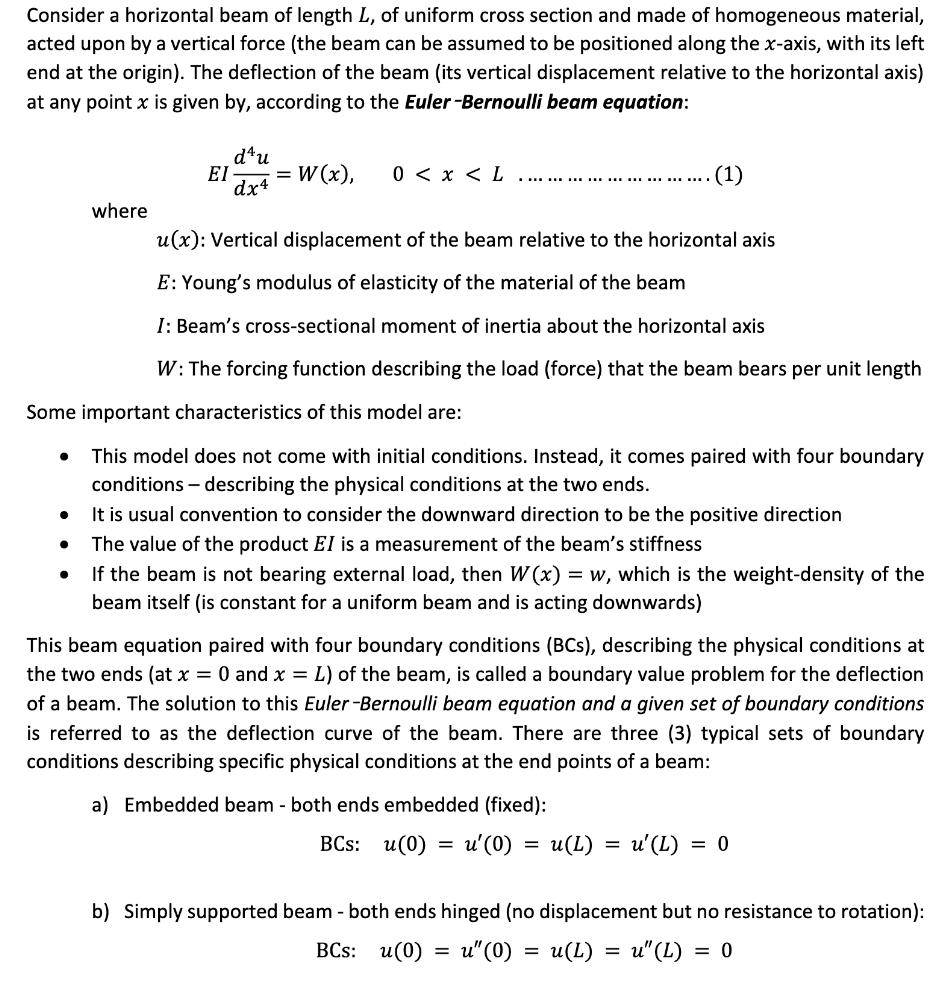Answered step by step
Verified Expert Solution
Question
1 Approved Answer
Consider a horizontal beam of length L, of uniform cross section and made of homogeneous material, acted upon by a vertical force (the beam


Consider a horizontal beam of length L, of uniform cross section and made of homogeneous material, acted upon by a vertical force (the beam can be assumed to be positioned along the x-axis, with its left end at the origin). The deflection of the beam (its vertical displacement relative to the horizontal axis) at any point x is given by, according to the Euler-Bernoulli beam equation: . where d'u = W (x), 0 < x < L dx4 Some important characteristics of this model are: This model does not come with initial conditions. Instead, it comes paired with four boundary conditions - describing the physical conditions at the two ends. (1) u(x): Vertical displacement of the beam relative to the horizontal axis E: Young's modulus of elasticity of the material of the beam I: Beam's cross-sectional moment of inertia about the horizontal axis W: The forcing function describing the load (force) that the beam bears per unit length It is usual convention to consider the downward direction to be the positive direction The value of the product EI is a measurement of the beam's stiffness If the beam is not bearing external load, then W(x) = w, which is the weight-density of the beam itself (is constant for a uniform beam and is acting downwards) This beam equation paired with four boundary conditions (BCs), describing the physical conditions at the two ends (at x = 0 and x = L) of the beam, is called a boundary value problem for the deflection of a beam. The solution to this Euler-Bernoulli beam equation and a given set of boundary conditions is referred to as the deflection curve of the beam. There are three (3) typical sets of boundary conditions describing specific physical conditions at the end points of a beam: a) Embedded beam - both ends embedded (fixed): BCs: u(0) = u' (0) = u(L) = u' (L) = 0 b) Simply supported beam - both ends hinged (no displacement but no resistance to rotation): BCs: u(0) = u"(0) = u(L) = u" (L) = 0 c) Cantilever beam (left end embedded, right end free): BCs: u(0) u' (0) u" (L) = = 1. Find the homogeneous solution to this 4th order ODE. = u"" (L) = 0 2. Find a particular solution to this 4th order ODE using undetermined coefficients when the beam is not bearing any external load. (then W(x) = w, a constant). Treat w, E and I as known constants. [when you choose the correct trial solution be mindful about it being a homogeneous solution] 3. Find the deflection curve of a beam (made of Naval Brass) of length, L = 50 in, bearing a load that is proportional to the distance from the left endpoint, i.e. W(x) = wx, with I = 10 and Young's modulus, E = 100 Gpa for each of the following cases: a) Both ends of the beam embedded b) Beam is simply supported c) Left end of the beam embedded, right end free
Step by Step Solution
There are 3 Steps involved in it
Step: 1

Get Instant Access to Expert-Tailored Solutions
See step-by-step solutions with expert insights and AI powered tools for academic success
Step: 2

Step: 3

Ace Your Homework with AI
Get the answers you need in no time with our AI-driven, step-by-step assistance
Get Started


